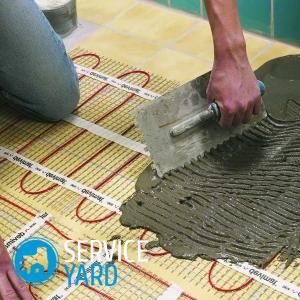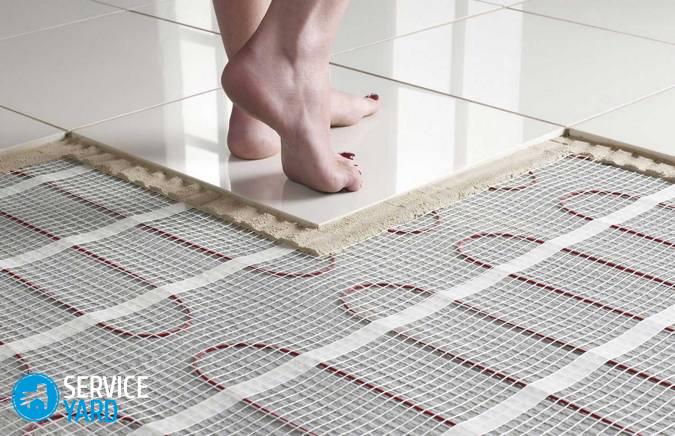How to choose a warm floor for tiles?

Nowadays, many people who make repairs in the apartment during the choice of flooring prefer tiles, because it looks very impressive, is practical and durable. Its most important advantage is a high level of thermal conductivity. Therefore, if you decide to make a warm floor, then this is an ideal basis for it. In summer it will be quite pleasant to walk on cool tiles, and in winter it will be very warm, creating a comfortable atmosphere in the house. And in this matter, the main thing is to understand how to choose a warm floor for the tile, and not vice versa. There are several types of floor heating system, and we will all consider them in more detail in this article.
to contents ↑What to look for when choosing a warm floor?
There are several factors that must be taken into account before choosing a warm floor for the tile and installing it in your home. We will get acquainted with the selection criteria, what to look for.
Primary or secondary heat source
Typically, this heating option is used as an auxiliary and allows you to additionally heat the room. You may wish to use a warm floor as the main heating in the winter - then it is better to pay attention to the liquid floor.
Important! It heats up due to the circulation of mineral oil or water in a pipeline located directly under the floor.
Continuous operation
The fact is that auxiliary systems can, like the liquid floor, be used in different ways. When the duration of the continuous functioning of the warm floor comes to the fore, it is imperative to pay attention to the level of energy conservation.
Energy equipment at home
Before choosing a warm floor for the tile, you need to decide what energy resources you will use for heating. In apartment buildings, you don’t have to choose one, because the only source of energy is the power grid. But in a private house you can power the floor from an autonomous electric generator.
Type of premises
Warm floors that are used for kitchens, rooms, loggias or balconies have their own characteristics. It all depends on the complexity of the layout and quadrature of the premises.
Localization
The floor can be warm not only in the whole room, but also in a certain part of it, and this also needs to be taken into account.
Type of coating
That is, it can be mounted under the laminate, linoleum and tile. If the coatings in different rooms are different, you may have to buy various underfloor heating systems. And this will affect both cash costs and the time frame for completing repairs.
to contents ↑Classification of underfloor heating
To make a choice, you need to deal with an affordable range of floors presented by current manufacturers. The following options are available:
- Electric.
- Water.
- Infrared.
Important! The tile can be laid on any type of floor, because for insulation you just need to decompose the heating elements in those parts of the room where there will be no furniture or household appliances.
And now about each option in more detail.
Electric floor
So, what are the properties of this heating option and how to choose a warm electric floor under the tile? It is very important to first determine the thickness of the screed, which will cover the heating system from above.
Important! The fact is that this type of warm floor is a heating cable that can be laid as you like, for example, with a spiral or zigzag.
You can buy ready-made mats, with an already fixed cable using the grid. And this option is ideal for thin screed. The floor of this variety will be powered by the mains.
Important! Advantages of the electric floor:
- You can install it under any coating, be it tile, laminate or linoleum.
- Takes up a minimum of space.
- The heating level can be adjusted using a heat sensor.
Water floor heating
This heating system is considered the simplest, since it works on the basis of using a special liquid heated to the desired temperature, which circulates through the water supply system hidden inside the floor.
Such a system is connected to an autonomous gas boiler or central heating system. It looks like a set of metal-plastic or polyethylene tubes.
Important! Advantages of the water heating system:
- Universality. After all, it is suitable for any type of cladding. First, a screed is made, where the tubes are hidden.
- Availability. Such a floor is relatively inexpensive, and by the way, you can install it yourself.
- Low level of installation complexity. Such flexible pipes can be connected by anyone without special skills.
However, it must be remembered that creating a warm water floor in an apartment building will not be easy, and sometimes it is impossible from a technical point of view. And for this you will have to first go through many instances to obtain permissions and create a project.
Infrared floor
If you are thinking about how to choose a warm floor for the tile in the bathroom, then this heating system will be the ideal option. An infrared rod floor is perfect for any type of tile, as it guarantees a high level of heat in the house.
He eats on the same principle as the electric floor, but heats up completely differently. The main for his work are carbon rods, interconnected already at the place of work or sold in the form of ready-made solid mats.
Important! The main features of this gender:
- The minimum cost of electricity.
- High level of energy efficiency.
- Convenience of installation.
- The ability to adjust the heating level.
- Heating takes place in a given direction.
- The beneficial effects of radiation to improve the body.
There is another version of the infrared floor, namely the film one, which is characterized by easier installation due to the use of the film for heating. He is preferred in cases when it is impossible to make a thick screed:
- A heat-reflecting substrate is taken as a basis on which a roll with heating strips is spread and tiles are laid on top.
- Additionally, a sheet of gypsum fiber material is used, and the flooring is overlapped, so that it is convenient to connect the segments of the heating elements and provide power.
How to install a warm floor?
We already know how to choose a warm floor for the tile, and now it's time to understand the features of its installation. So that you do not have problems when laying a warm floor, it is recommended to give preference to heating mats. In fact, this is the same as the heating cable, they differ only in ease of installation.
Important! Mats must be laid directly in the glue for the tile, and the mesh attached cable in this case plays the role of reinforcement.
Let's look at the main stages of laying a warm floor using the example of mats as heating elements:
- At the first stage, we draw a layout of the heating system. We mark the locations of large equipment and furniture on it, because at these points the system is not laid. We also determine the places where the temperature regulator and temperature sensor will be installed.
- At the second stage, special holes are cut in the floor and wall two and two centimeters wide and deep, respectively. A special tube with a temperature sensor cable and a connecting cable is laid in it.
- In the third stage, the floor base is leveled. It is very important to make sure that the floor is perfectly smooth, otherwise - during operation, problems with the operation of the heating system may occur.
- At the fourth stage, we install a temperature sensor. To do this, it is necessary to extend the sensor cable into a special corrugated tube, install a plug on it and lay it in the hole made earlier. The sensor is placed between two adjacent turns of cable.
- The fifth stage involves laying a heating mat. During the execution of this work, you must ensure that the cable turns do not intersect with each other.
- The sixth stage involves the installation of the system. To prevent mats from moving during tile laying, it is recommended that the reinforcing mesh be glued to the concrete floor.
- At the seventh stage, we test the installed system.
- The eighth stage is the coating of mats with special glue for tiles. Moreover, they need to completely cover the entire surface of the mats, so that the system becomes more rigid.
- The ninth stage is retesting the system.
- At the tenth stage, we lay the tiles and connect the warm floor to electricity.
Stock footage
Having studied the basic selection criteria and recommendations for laying technology, you can quickly decide which floor to choose for the tiles in the bathroom, kitchen or room. Thanks to the installation of such a system, you will live in the most comfortable conditions at any time of the year.
- How to choose a vacuum cleaner taking into account the characteristics of the house and coatings?
- What to look for when choosing a water delivery
- How to quickly create comfort at home - tips for housewives
- How to choose the perfect TV - useful tips
- What to look for when choosing blinds
- What should be running shoes?
- What useful things can you buy in a hardware store
- Iphone 11 pro max review
- Than iPhone is better than Android smartphones




